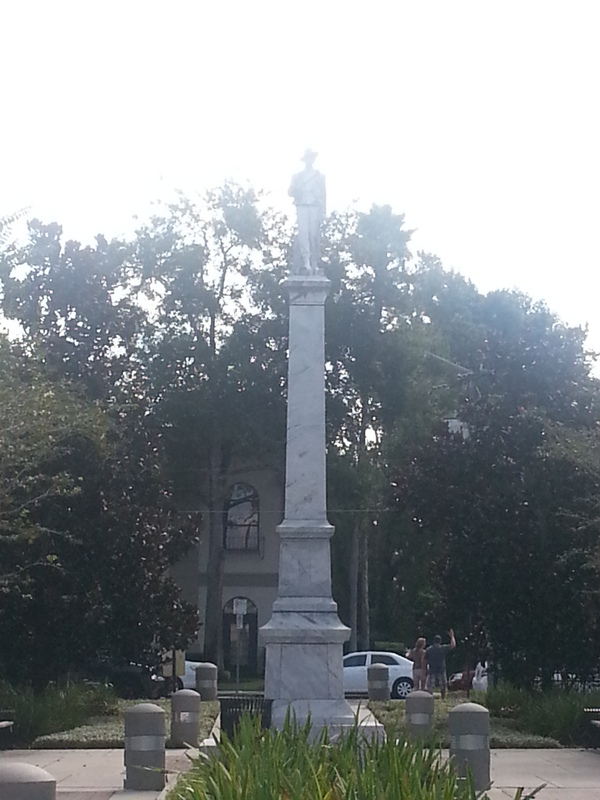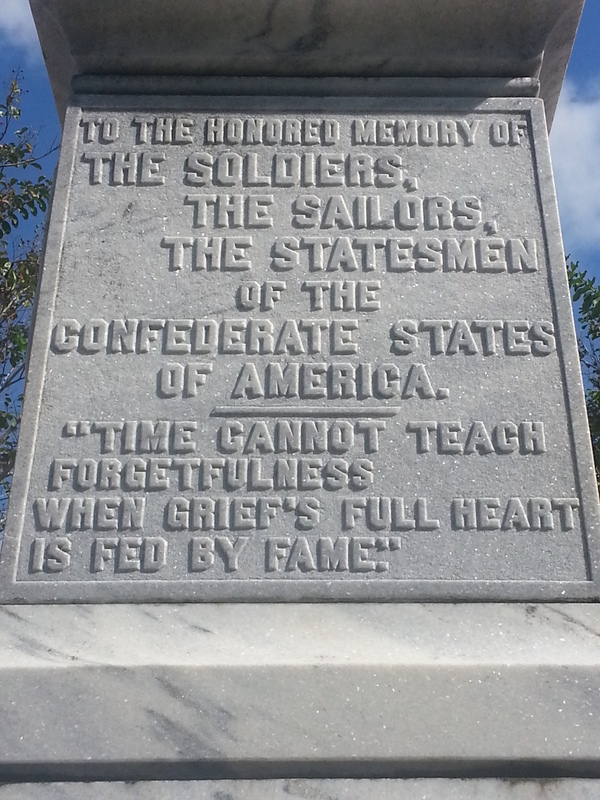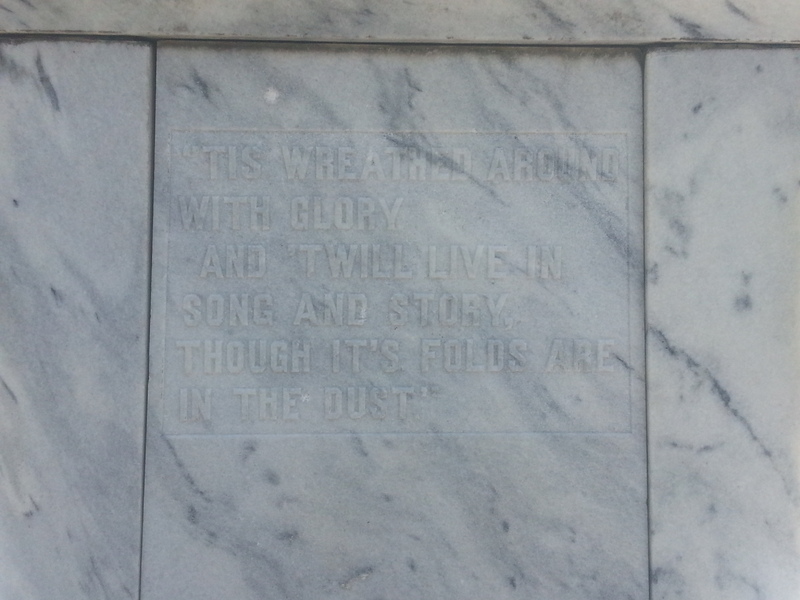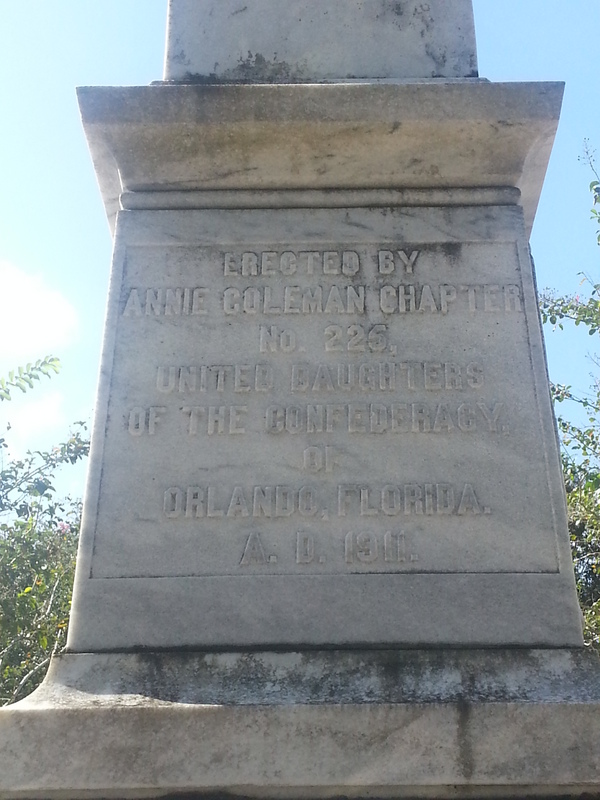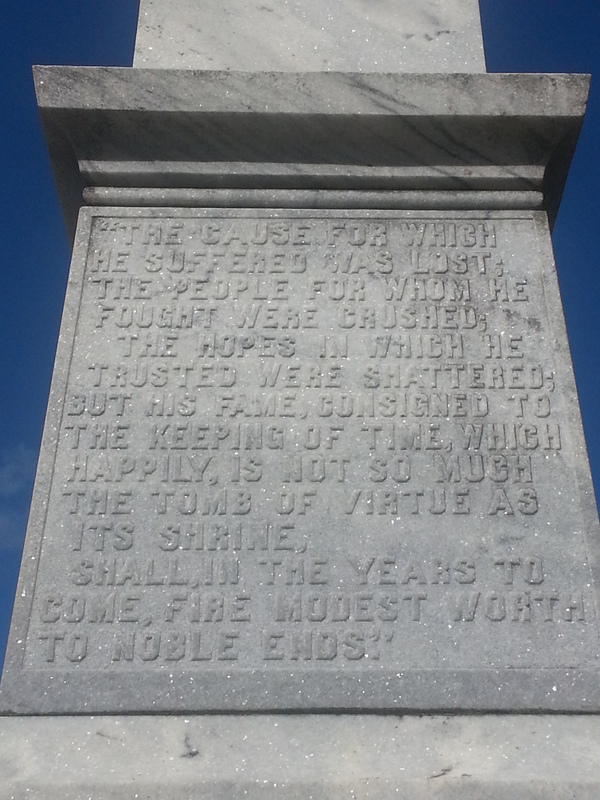1911 Confederate Soldier Monument
When strolling around Lake Eola there is an array of sculptures and monuments that grab the eye, yet the history of these seemingly benign objects are rarely considered. One monument that has a unique history is the 1911 Confederate Soldier Monument, which overlooks not only Lake Eola but also the ever burgeoning downtown of Orlando.
When looking back at the Civil War, certain states appear as prominent figures such as: Virginia, Massachusetts, South Carolina, Tennessee, and Georgia. One state goes by unnoticed amongst the battles and proclamations, Florida, who seceded the union after South Carolina and Mississippi.[1] It is estimated that 15,000 Floridian men served in the Confederacy and just a little over 1,200 served in the Union.[2] Additionally it is estimated that a minimum of 5,000 Floridian soldiers died while serving.[3] Florida was an extremely valuable asset for the Confederacy, for they were able to provide cattle for the army. [4] In time, the Union focused on Florida's role in the Confederacy with the goal to start reconstruction and end the continuous supply of cattle, which resulted in The Battle of Olustee.[5] The Battle of Olustee was not only the biggest battle on Florida soil, but it resulted in one of the highest casualty losses percentage wise for the Union.[6] Though Florida was an important element in the Civil War, few know about this unique aspect of Florida's past.
In the winter of 1908, Mrs. Abernathy, the president of the Annie Coleman Chapter of the Daughters of the Confederacy, envisioned a monument with the goal of honoring the men who served in the Confederacy during the Civil War.[7] At the following meeting in December of 1908, the Annie Coleman chapter agreed upon the idea of creating a monument and started multiple fundraisers over the course of the year.[8] A year later in December of 1909, the women were faced with not only the expense of the monument, but also designing it.[9] The monument they designed included a six-foot marble confederate soldier standing atop a thirty-five foot monument.[10] The total cost of the marble monument was $2,500.[11] By calculating today's inflation rate, the cost of the monument would be approximately $60,000.[12]
There was a committee to discuss the two possible locations for the monument: overlooking Lake Eola or standing sentinel across the Orange County Courthouse (which is now the Orange County Regional History Center). On June 3, 1911 it was erected across from the Courthouse at the intersection of Main Street and Central Avenue.[13] The Confederate Soldier Monument resided at the intersection until 1917 when it was deemed a traffic hazard, thus relocating to the east side of Lake Eola.[14]
The 1911 Confederate Soldier Monument was created to honor the Confederate soldiers and ensure that through the years to come, the soldiers' deeds will never be forgotten. The monument is also a testament of how one voice can evoke not only discussion, but also the creation of a lasting tribute. For this monument is not only honoring the Confederate Soldiers, but also the perseverance of the women who recognized the historical impact of the creation of their monument. As the years progress it is important to have these lasting tributes lest we forget the sacrifices of those gone before.
On June 20, 2017, a century after being moved to Lake Eola Park, the nearly 9-ton statue was transferred to a section of Greenwood Cemetery in Orlando set aside for Confederate veterans. [15] A time capsule was discovered when the base was dismantled. Although defenders of the statue protested at a City Council meeting in May, there was no resistance to the monument’s removal.[16] Orlando Mayor John Hugh “Buddy” Dyer had announced plans to remove the statue a month prior, but the city never released a specific date.
[1] Lewis Nicholas Wynne and Robert A. Taylor, Florida in the Civil War (Arcadia Publishing, 2002), 7.
[2] William Watson Davis, The Civil War and Reconstruction in Florida (Columbia University, 1913), 53: 322-323.
[4] Robert A. Taylor "Rebel Beef: Florida Cattle and the Confederate Army," The Florida Historical Quarterly 67, no. 1 (July 1988): 15.
[5] David J. Coles and Richard J. Ferry, "The Smallest Tadpole," Florida Memory, accessed November 26, 2013, http://www.floridamemory.com/onlineclassroom/ floridacivilwar/history/.
[6] Coles and Ferry, "The Smallest Tadpole."
[7] A.G. Branham, "History of the Confederate Monument" (paper presented at the Annie Coleman Chapter U.D.C., Orlando, Florida, April 12, 1917) Orange County Regional History Center.
[8] Ibid.
[9] Ibid.
[10] "The Confederate Monument: A Work Of Art-A Splendid Ornament To Orlando," February 16, 1911, Confederate Soldier Monument Collection, Orange County Regional History Center.
[11] Branham, "History of the Confederate Monument."
[12] "Inflation Calculator 2013," DaveMaunel.Com, accessed November 24, 2013, http://www.davemanuel.com/inflation-calculator.php?.
[13] Branham, "History of the Confederate Monument."
[14] Michael Griffin, "Faded Gray This Friday Is Confederate Memorial Day. They Remember," The Orlando Sentinel, April 12, 1985, accessed September 28, 2013, http://articles.orlandosentinel.com/1985-04-21/news/0290200120_1_hogan-confederate-memorial-day-city-of-orlando/3.
[15] Jeff Weiner, “Confederate statue ‘Johnny Reb’ dismantled for move to Greenwood Cemetery,” The Orlando Sentinel, June 20, 2017, accessed June 20, 2017, http://www.orlandosentinel.com/news/breaking-news/os-lake-eola-confederate-statue-moved-20170619-story.html.
[16] Ibid.
